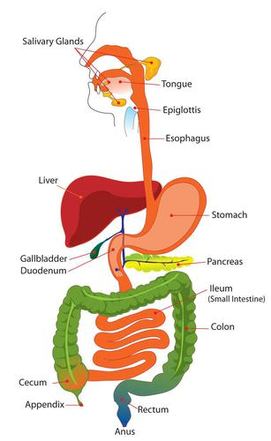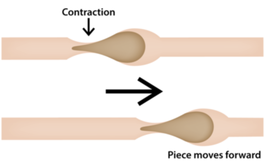Digestion basics: Polymers --> Monomers
|
Digestion is the process of breaking down larger molecules into smaller molecules. This process happens in the digestive system (learn more about the digestive system below).
Polymers are large molecules such as carbohydrates, lipids, and proteins. These large molecules can be broken down into smaller molecules called monomers. Monomers are small enough to enter the blood stream where they can be moved into individual cells. |
POLYMER --> MONOMERS
Large organic molecule --> small organic molecule Proteins --> amino acids Carbohydrates --> sugars Lipids --> glycerol + fatty acids |
Biosynthesis basics: Monomers --> Polymers
|
Biosynthesis is the process that builds larger molecules from smaller ones. In simple terms, monomers enter the cell and are then combined to make polymers. Monomers of sugar combine to make carbohydrates. Monomers of amino acids combine to make proteins. Monomers of glycerol and fatty acids are combined to make lipids.
Monomers can be thought of as legos, they are building blocks that can be combined in different ways to make different structures. Different combinations of amino acids make different proteins. Different combinations of sugars make different carbohydrates. The cell will combine the monomer building blocks together into the polymers that it needs in order to grow. |
MONOMERS --> POLYMERS
Small organic molecules --> Large organic molecules Amino acid + amino acid ... --> proteins Sugar + sugar + sugar ... --> carbohydrates Glycerol + fatty acid ... --> lipids |
|
|
|
The Digestive System:
|
Specifically, our energy comes from what?
The respiratory and circulatory systems work together to provide cells with the oxygen they need for cellular respiration. Cells also need glucose for cellular respiration. Glucose is a simple sugar that comes from the food we eat. To get glucose from food, digestion must occur. This process is carried out by the digestive system. Suppose you are studying and having trouble concentrating. You decide to eat an apple for energy. How does energy stored in the apple get into your cells? What organs and processes break down the apple into nutrients that the body can use for fuel? What organs and processes let the nutrients enter your bloodstream so that they can travel to the cells where they are needed? The digestive system has three main functions: digestion of food, absorption of nutrients, and elimination of solid waste. Digestion is the process of breaking down food into components the body can absorb. There are two types of digestion: mechanical and chemical.
|
Different organisms have different digestive systems. Simple organisms, like earthworms, have a simplistic digestive systems. Complex organisms, like humans, have digestive systems with complex structures and accessory organs.
Despite these differences, the purpose of all digestive systems is to breakdown food molecules until they are small enough to enter individual cells. This chemical digestion must occur before individual cells can absorb the food molecules. |
Chemical digestion could not take place without the help of digestive enzymes. Enzymes are substances that speed up chemical reactions. Digestive enzymes speed up the breakdown of polymers into monomers. Digestive enzymes are secreted by glands in the mucous membranes of the mouth, stomach, small intestine, and pancreas. Enzymes are specific to the type of molecule they can work with, so there are different digestive enzymes help break down different types of food molecules.
After food is digested, the resulting nutrients are absorbed. Absorption is the process in which substances pass into the blood stream where they can circulate throughout the body. Absorption occurs mainly in the small intestine. Any remaining indigestible matter that cannot be absorbed passes into the large intestine as waste. The waste later passes out of the body through the anus in the process of elimination.
- Carbohydrates are broken down into sugars by carbohydrases.
- Proteins are broken down into amino acids by proteases.
- Lipids are broken down into glycerol and fatty acids by lipases.
After food is digested, the resulting nutrients are absorbed. Absorption is the process in which substances pass into the blood stream where they can circulate throughout the body. Absorption occurs mainly in the small intestine. Any remaining indigestible matter that cannot be absorbed passes into the large intestine as waste. The waste later passes out of the body through the anus in the process of elimination.
|
Organs of the human digestive system
Organs that make up the digestive system are shown in the image to the right. Most of the organs form the gastrointestinal tract. Other digestive organs are called accessory organs. As you read about the organs below, refer to the image to the right for reference. Gastrointestinal Tract
The gastrointestinal (GI) tract is a long tube that connects the mouth with the anus. It is more than 9 meters long in adults. The GI tract can be divided into an upper and lower part. The upper GI tract includes the mouth, esophagus, and stomach. The lower GI tract includes the small and large intestines. Food enters the mouth, passes through the upper and lower GI tracts, and then exits the body as feces through the anus. The organs of the GI tract are covered by two layers of muscles that enable peristalsis. Peristalsis is a rapid, involuntary, wave-like contraction of muscles. It pushes food through the GI tract. The inside of GI tract is lined with mucous membranes. Mucous membranes are moist tissues that can secrete and absorb substances. The ability to secrete and absorb substances is necessary for the functions of the digestive system. Accessory Organs of the Digestive System In the lower GI tract, additional organs play important roles in digestion. They are called accessory organs. Food does not pass through them, but they make or store substances needed for digestion. The accessory organs are the liver, gall bladder, and pancreas.
|
[1]
[2]
Image Attributions
|
This text is adapted from CK-12 under a Creative Commons 3.0 license. You can find the original source here.
|
|
Proudly powered by Weebly

